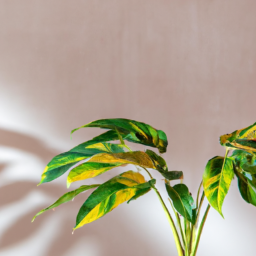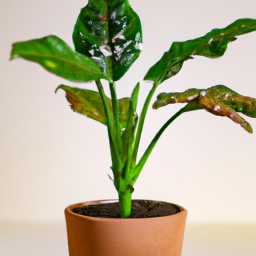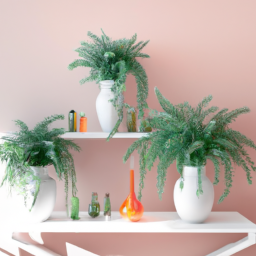
Have you ever noticed your indoor plants turning yellow and wondered why? It can be frustrating to see your beloved greenery losing its vibrant color. In this blog post, we will explore the reasons behind why indoor plants become yellow and provide some helpful tips on how to prevent and treat this common issue. So, if you’re curious about the health of your indoor plants, keep reading to learn more about why indoor plants become yellow.
Common Reasons Why Indoor Plants Turn Yellow
Introduction
Indoor plants can bring life and beauty to any space, but when they start turning yellow, it can be a cause for concern. There are several common reasons why indoor plants may turn yellow, and understanding these factors can help you address the issue and keep your plants healthy and vibrant.
Poor Lighting
One of the most common reasons why indoor plants turn yellow is due to poor lighting. Plants need sufficient light to photosynthesize and thrive, and when they don’t get enough light, their leaves can start to turn yellow. If your plant is not receiving adequate sunlight, consider moving it to a brighter location or supplementing with artificial light.
In addition, be mindful of the type of light your plant needs. Some plants prefer direct sunlight, while others thrive in indirect light. Understanding your plant’s light requirements can help prevent yellowing leaves.
Lastly, be cautious of overexposure to sunlight, as this can also cause yellowing. If your plant is receiving too much direct sunlight, consider moving it to a location with filtered light to prevent leaf damage.
Overwatering or Underwatering
Another common reason why indoor plants turn yellow is due to overwatering or underwatering. Both of these extremes can stress the plant and lead to yellowing leaves. Overwatering can cause root rot, which inhibits the plant’s ability to take up nutrients, while underwatering can result in nutrient deficiencies.
To prevent overwatering, make sure your plant is in a well-draining pot and only water when the top inch of soil is dry. For underwatering, establish a consistent watering schedule and ensure that your plant is receiving adequate moisture.
It’s important to strike a balance between watering too much and too little to keep your plant healthy and green. Monitor your plant’s soil moisture levels and adjust your watering routine as needed to prevent yellowing leaves.
Nutrient Deficiencies
Indoor plants require essential nutrients to grow and thrive, and a lack of these nutrients can cause yellowing leaves. Common nutrient deficiencies that can lead to yellowing include nitrogen, iron, and magnesium. Nitrogen deficiency, for example, can result in overall yellowing of the plant, while iron deficiency can cause yellowing between the veins of the leaves.
To address nutrient deficiencies, consider fertilizing your plant with a balanced fertilizer to provide the necessary nutrients. Be mindful of the specific needs of your plant, as different species may require different types of fertilizers. Regularly inspect your plant for signs of nutrient deficiencies and adjust your fertilization routine accordingly.
In addition to fertilization, you can also amend the soil with organic matter to improve nutrient uptake and overall plant health. By addressing nutrient deficiencies, you can help prevent yellowing leaves and promote lush, green growth in your indoor plants.

Why Indoor Plants Become Yellow
As an expert in indoor plant care, I understand the frustration that comes with seeing your beloved plants turn yellow. There are several reasons why indoor plants may start to yellow, and it’s important to identify the cause in order to address the issue effectively.
Insufficient Light
One of the most common reasons why indoor plants turn yellow is due to insufficient light. Plants need light to photosynthesize and produce energy, so if they are not getting enough light, they may start to show signs of stress. This can manifest as yellowing leaves, as the plant is unable to produce enough chlorophyll to sustain its growth.
To prevent this issue, make sure to place your indoor plants in a location where they can receive adequate sunlight. If natural light is limited, consider using grow lights to supplement the light your plants are receiving.
Additionally, be mindful of the specific light requirements of each plant species, as some may require more light than others. Adjust the placement of your plants accordingly to ensure they are getting the right amount of light to thrive.
Overwatering
Another common cause of indoor plants turning yellow is overwatering. When plants are watered too frequently or the soil is not well-draining, the roots can become waterlogged and suffocate. This can lead to root rot, which in turn affects the plant’s ability to take up nutrients and water, resulting in yellowing leaves.
To prevent overwatering, make sure to allow the soil to dry out between waterings. Use a moisture meter to gauge the moisture level of the soil before watering, and adjust your watering schedule accordingly. Ensure that your pots have proper drainage holes to allow excess water to escape, preventing water from pooling at the bottom of the pot.
If you suspect that your plant is suffering from root rot, gently remove it from its pot and inspect the roots. Trim away any rotting or mushy roots, repot the plant in fresh soil, and adjust your watering practices to prevent future issues.
Nutrient Deficiency
A nutrient deficiency can also cause indoor plants to turn yellow. Plants require a balance of essential nutrients, such as nitrogen, phosphorus, and potassium, to thrive. If a plant is lacking in any of these nutrients, it may exhibit symptoms such as yellowing leaves, stunted growth, or leaf drop.
To prevent nutrient deficiencies, make sure to fertilize your indoor plants regularly with a balanced fertilizer. Follow the instructions on the fertilizer packaging to avoid over-fertilizing, which can also be detrimental to plant health. Additionally, consider using a slow-release fertilizer to provide a steady supply of nutrients to your plants over time.
Monitor your plants for any signs of nutrient deficiencies, such as yellowing leaves or poor growth, and adjust your fertilization schedule as needed. Remember that different plants have different nutrient requirements, so be sure to research the specific needs of each plant species in your care.

Tips for troubleshooting yellowing indoor plants
Are your indoor plants looking a little under the weather? Seeing yellow leaves on your beloved greenery can be disheartening, but fear not! There are several common reasons why indoor plants turn yellow, and with a little detective work, you can get to the root of the problem and bring your plants back to their vibrant green selves.
Potting mix issues
One common reason why indoor plants turn yellow is due to issues with the potting mix. Over time, potting mix can become compacted, preventing proper drainage and aeration for the plant’s roots. This can lead to root rot, which in turn causes yellowing leaves. To remedy this issue, gently loosen the potting mix with a fork or repot the plant in fresh, well-draining soil.
Another potting mix issue that can cause yellowing leaves is nutrient deficiency. If your plant is not receiving enough essential nutrients like nitrogen, iron, or magnesium, its leaves may start to turn yellow. Consider fertilizing your plant with a balanced, water-soluble fertilizer to give it the nutrients it needs to thrive.
Lastly, be mindful of the type of potting mix you are using for your indoor plants. Some plants require specific types of soil, such as cacti and succulents needing a well-draining mix, while others prefer a more moisture-retentive mix. Make sure you are using the right potting mix for your plant’s specific needs to prevent yellowing leaves.
Watering issues
Another common culprit behind yellowing indoor plants is watering issues. Overwatering can lead to root rot, which causes the plant’s leaves to turn yellow and eventually die off. On the other hand, underwatering can also cause yellowing leaves as the plant becomes stressed from lack of water.
To determine if your plant is being overwatered or underwatered, check the soil moisture level by sticking your finger into the soil. If the soil feels soggy or wet, your plant is likely being overwatered. If the soil feels dry and crumbly, it may be time to give your plant a good drink. Adjust your watering schedule accordingly to ensure your plant is getting the right amount of moisture.
Additionally, consider the humidity levels in your home, as some plants require higher humidity levels to thrive. If your indoor air is too dry, consider using a humidifier or placing a tray of water near your plants to increase humidity and prevent yellowing leaves.
Pest infestations
One often overlooked reason for yellowing indoor plants is pest infestations. Common pests like spider mites, aphids, and mealybugs can suck the sap from your plant’s leaves, causing them to turn yellow and eventually die. Keep an eye out for any signs of pests, such as webbing, sticky residue, or small insects on your plant.
To combat pest infestations, gently wipe down your plant’s leaves with a damp cloth to remove any pests and their eggs. You can also use insecticidal soap or neem oil to treat pest infestations naturally. Regularly inspect your plants for signs of pests and take action promptly to prevent further damage.
By addressing potting mix issues, watering problems, and pest infestations, you can troubleshoot yellowing indoor plants and help them thrive once again. Remember to observe your plants closely, make adjustments as needed, and give them the care and attention they deserve to keep them healthy and happy.
Recap of this article
Have you ever noticed that your indoor plants start to turn yellow, despite your best efforts to care for them? It can be frustrating and confusing to see your beloved greenery lose its vibrant color. There are a few common reasons why indoor plants may turn yellow, and understanding these factors can help you address the issue and get your plants back to their healthy state.
One of the main reasons indoor plants turn yellow is due to overwatering. When plants receive too much water, their roots can become waterlogged and suffocate, leading to yellowing leaves. Another common cause of yellowing plants is lack of sunlight. Plants need sunlight to photosynthesize and produce energy, so if they are not receiving enough light, they may start to lose their green color. Additionally, nutrient deficiencies, pests, and environmental stressors can also contribute to yellowing leaves. By identifying the root cause of the issue, you can take the necessary steps to correct it and help your indoor plants thrive once again.
Here are this week’s Top Questions and Answers
Q1. Why do indoor plants turn yellow?
A1. Indoor plants can turn yellow due to a variety of reasons, including overwatering, underwatering, lack of sunlight, nutrient deficiencies, pests, or diseases.
Q2. How can overwatering cause indoor plants to turn yellow?
A2. Overwatering can lead to root rot, which inhibits the plant’s ability to take up nutrients and oxygen, resulting in yellowing leaves. It is important to allow the soil to dry out between waterings to prevent this issue.
Q3. What role does sunlight play in indoor plants turning yellow?
A3. Indoor plants require adequate sunlight to photosynthesize and produce energy. If a plant is not receiving enough light, it may not be able to produce enough chlorophyll, leading to yellowing leaves.
Q4. How can I prevent indoor plants from turning yellow due to nutrient deficiencies?
A4. To prevent nutrient deficiencies, it is important to use a balanced fertilizer and ensure that the plant is receiving all the necessary nutrients. Regularly inspecting the plant for signs of nutrient deficiencies and adjusting the fertilizer accordingly can help prevent yellowing.
Q5. What should I do if my indoor plant is turning yellow?
A5. If your indoor plant is turning yellow, first identify the potential cause, such as overwatering, lack of sunlight, or nutrient deficiencies. Once you have identified the issue, take appropriate steps to address it, such as adjusting your watering schedule, moving the plant to a sunnier location, or fertilizing as needed. If the problem persists, consider seeking advice from a plant expert.
Dr. Olivia Green is a botanist with over two decades of experience in indoor plant cultivation. She holds a Ph.D. in Plant Biology and has dedicated her career to researching plant behavior in controlled environments. Dr. Green is passionate about helping plant enthusiasts master the art of indoor gardening through her extensive knowledge and practical insights.


